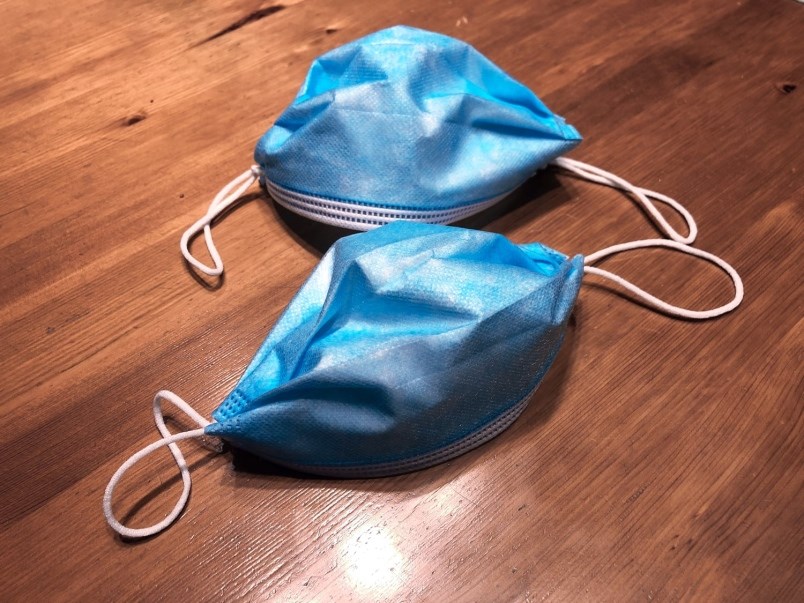If your eyeglasses easily fog up when you’re wearing a mask to protect against COVID-19, it's probably a sign that the mask isn’t fitting tight enough.
That’s what the experts are saying in a bunch of articles I’ve been reading.
But going tight can be a pain, as those earloops dig into the back of your ears.
Here are some approaches I’ve been experimenting with to achieve a tighter fit with minimum pain. My success has varied.
The two basics:
- Make sure your mask has an adjustable nose strip; mold that nose strip as tight as possible to your face.
- Adjust your straps so that the edges of the mask fit tight against your face, eliminating gaps as much as possible.
With an earloop mask, you can twist the earloops to make them shorter, or find a model with adjustment toggles. You can also go tighter, and avoid ear pain, with the help of a button strip, or a hat or a headband with buttons. Place the button strip at the back of your neck or head, and hook the earloops onto the buttons.
Or wear masks that use headbands. The headband versions have two straps, one going to the top back of your head, the other to the back of your neck. Headband-style masks can fit tighter than ones with earloops.
I’ve also tried these approaches.
• For disposable pleated rectangular medical masks, use the knot and tuck method. (Here’s an excellent video on YouTube explaining how to do it.)
Knot the earloops as close as possible to the mask, tuck in the left and right edges to get rid of the gaps. Watch the video to get a clearer idea of what this is all about. I didn’t understand the concept until I watched it.
The resulting mask will cover less of your face, but it’ll be tighter and reduce gaps. The mask also becomes cupped so that the front doesn’t touch your face. I find the cupping makes it easier to breathe.
On my first few tries, I failed to duplicate the result in the video. I eventually found that the tucking part needs to involve creasing to prevent the mask from gapping.
I’ve worn knot-and-tuck masks outdoors quite a bit and the reduction in fogging of glasses is significant.
• Double mask. When I’ve worn two masks, I’ve found that the second one pulls things tighter. Wear a disposable medical mask, then put a fabric mask on top. Or wear two disposable medical masks. Breathing is not significantly impeded. But wearing two fabric masks is too much and really muffles your voice. The two-mask approach also helps to keep your face warm when you’re out for a stroll in winter. Some health groups are beginning to recommend double masking, backed up by research that suggests two masks provide better protection. The American Centers for Disease Control and Prevention suggests double masking.
The U.S. CDC also mentions the option of putting a sleeve of sheer nylon hosiery around your neck and pulling it up over your mask to tighten fit and reduce gaps.
The best double-mask option I’ve tried is a cloth mask using adjustable head straps, with tightness controlled by a toggle; the cloth mask goes on top of a disposable medical mask. It’s fairly comfortable, and the head strap allows for the cloth mask to be pulled tight at the edges, but not touch the mouth or nostrils, creating a little pocket that makes breathing easier.
• Use a mask fitter or brace. These are just starting to appear. They’re strap contraptions that go around the edges of masks and then behind your head, where there’s a tightening mechanism. When I described the concept to a colleague, she said: Huh? Check the photo.
• This one doesn’t lead to tighter fit. Wear the mask closer to the bottom of your eyes. I’ve found less fogging when the top of the mask is pulled into a position where the glasses nose pads sit on the mask’s nose strip.
• Avoid looking down. I’ve found an increase in fogging when I tilt my neck down.
• Try one of those anti-fog cloths for your glasses. But reviews online are definitely mixed. I have not tried this.
• If you’re facing a higher-risk situation (working in a store where you have frequent contact with strangers, for example), consider the gold-standard N95 mask. They offer top-level filtration and, with their elastic headbands, a tight fit. We’ve been admonished to not wear these masks, because they are in short supply, and should be left for health workers. But I’ve read several reports in recent weeks saying it’s become clear that it’s more of a distribution problem than a supply problem. And to add to the complexity with counterfeit worries thrown in. We need guidance from health officials on where to buy legitimate versions of these masks.
Canadian companies are beginning to make them, including some on the Lower Mainland, such as Novo Textiles, InnoLifeCare and Eternity Medical Equipment. But according to their websites, they are still waiting for blessings from the U.S. NIOSH workplace safety agency, though Health Canada has the Eternity version on its approved list. These built-to-be-disposed N95 masks are expensive compared with the single-use pleated ones, costing $3 to $5 each at retail, versus 40 cents to $1.
A story from The York Times: Can’t Find an N95 Mask? This Company Has 30 Million That It Can’t Sell
And from The Associated Press: Hospitals still ration medical N95 masks as stockpiles swell
Government investigating massive counterfeit N95 mask scam
Health Canada has a searchable database for medical devices: Health Canada: Authorized medical devices for uses related to COVID-19
Phillip Jang is news editor at the Times Colonist, in Victoria, British Columbia. He has lived on Vancouver Island since 1997.




